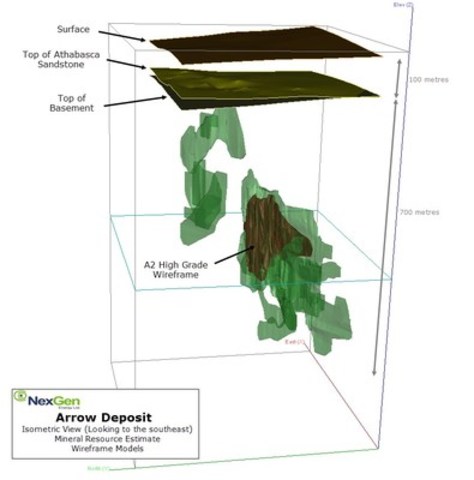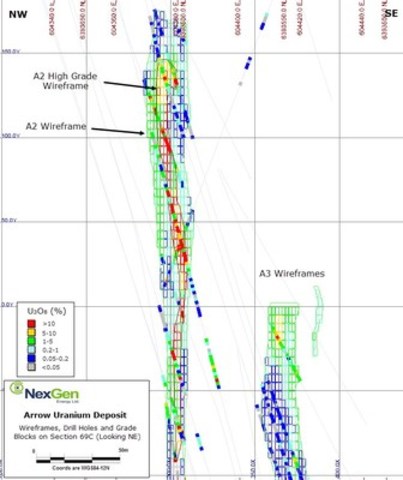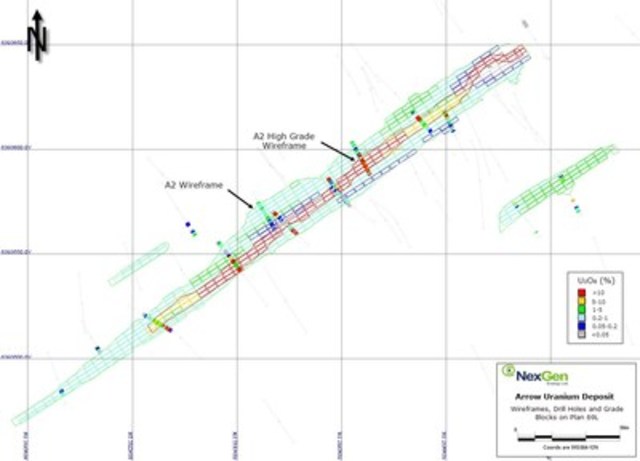NexGen Announces Maiden Mineral Resource Estimate for the Arrow Deposit of
posted on
Mar 03, 2016 06:36AM

Click "edit fast facts" to make changes

Canada NewsWire
VANCOUVER, March 3, 2016

VANCOUVER, March 3, 2016 /CNW/ - NexGen Energy Ltd. ("NexGen" or the "Company") (TSXV:NXE, OTCQX:NXGEF) is pleased to announce the results of its maiden independent Mineral Resource estimate for the Arrow uranium deposit on the Company's 100% owned Rook I property in Saskatchewan's Athabasca basin. Based on holes drilled and assayed to the end of October 2015 (AR-14-01 to AR-15-62), the estimate is an Inferred Mineral Resource of 201.9 M lbs of U3O8 contained in 3.48 M tonnes of mineralization grading 2.63% U3O8.
Tables 1 and 2 summarize the Arrow Mineral Resource Estimate and Sensitivity to Cut-Off Grade, respectively.
Table 1 - Arrow Inferred Mineral Resource Estimate Summary as of January 14, 2016 (the "Effective Date")
|
Structure |
Tonnage (tonnes) |
Grade (U3O8 %) |
Metal U3O8 (U3O8 lbs) |
|
A1 |
380,000 |
0.50 |
4,200,000 |
|
A2 |
1,480,000 |
0.85 |
27,600,000 |
|
A2 High Grade |
410,000 |
13.26 |
120,500,000 |
|
A3 |
1,130,000 |
1.90 |
47,300,000 |
|
A4 |
80,000 |
1.35 |
2,300,000 |
|
Total |
3,480,000 |
2.63 |
201,900,000 |
|
Notes: |
|
|
1. |
CIM Definition Standards were followed for Mineral Resources. |
|
2. |
Mineral Resources are reported at a cut-off grade of 0.25% U3O8 based on a long-term price of US$65 per lb U3O8 and estimated costs. |
|
3. |
A minimum mining width of 2.0 m was used. |
|
4. |
Numbers may not add due to rounding. |
|
Table 2 - Arrow Mineral Resource Sensitivity to Cut-Off Grade as of the Effective Date |
|||
|
Cut-Off (U3O8 %) |
Tonnage tonnes) |
Grade (U3O8 %) |
Metal (U3O8 lbs) |
|
0.25 |
3,480,000 |
2.63 |
201,900,000 |
|
0.30 |
3,220,000 |
2.82 |
200,300,000 |
|
0.50 |
2,510,000 |
3.51 |
194,300,000 |
|
1.00 |
1,490,000 |
5.43 |
178,300,000 |
|
2.00 |
820,000 |
8.66 |
157,200,000 |
|
2.50 |
680,000 |
10.04 |
150,100,000 |
|
3.00 |
580,000 |
11.30 |
144,200,000 |
|
5.00 |
400,000 |
14.70 |
128,500,000 |
|
10.00 |
220,000 |
20.78 |
101,300,000 |
Highlights:
Garrett Ainsworth, Vice-President, Exploration and Development, commented: "Arrow is now officially a world class high grade uranium deposit containing 201.9 M lbs at 2.63% U3O8 of Inferred Mineral Resources. This maiden resource is based on 59,796 m of drilling where 80 out of 82 holes hit disseminated to massive uranium mineralization associated with four stacked sub-vertical shear zones starting from 100m below surface. Arrow is uniquely 100% land based with mineralization entirely basement-hosted with very low concentrations of deleterious elements associated with the uraninite-dominated mineralization presenting straightforward geochemistry with respect to processing. The Arrow deposit's maiden resource is an incredible milestone for NexGen and its shareholders, and showcases the southwest Athabasca Basin as one of the most important districts globally."
Leigh Curyer, Chief Executive Officer commented: "Arrow has developed into the largest undeveloped uranium asset in the Athabasca Basin. It has been achieved at an unprecedented speed and truly sets one for the record books in terms of cost of discovery at approximately $0.13 per pound U3O8. An achievement reflecting the technical expertise, commercial management and disciplines of the entire NexGen team. Arrow is in its infancy and the NexGen team is looking forward to continued resource and project development to achieve its goal of becoming a major global supplier of nuclear fuel."
The high-grade, basement-hosted Arrow deposit was discovered in February 2014, and has rapidly grown into one of the largest uranium deposits in the world. Arrow is a sub-vertical, planar deposit that has a remarkable vertical extent. At its highest point, mineralization reaches the sub-Athabasca unconformity, 100 m below surface. The Mineral Resource reported herein extends to a depth of 800 m below surface. Wide spaced drill holes beneath the Mineral Resource have intersected mineralization at depths of up to 920 m below surface. The deposit as defined in the Mineral Resource estimate is comprised of several stacked lenses within an overall strike length of 645 m. The individual lenses vary in thickness from 4 m to 25 m.
Conference Call
NexGen will host a conference call today, Thursday March 3, 2016 at 8:30 a.m. Eastern Standard Time. Participants may join the conference call using the following call-in details:
Local/International: +1 416 764 8688
North America Toll Free: +1 888 390 0546
A replay of this conference call will be available until Monday May 2, 2016. The playback numbers are:
Local/International: +1 416 764 8677
North America Toll Free: +1 888 390 0541
Playback Passcode: 556239 #
Geology and Mineralization
The Rook I Property is located along the southwestern edge of the Athabasca Basin, straddling the Athabasca/basement unconformity. Basement rocks beneath the Athabasca sandstone belong to the Lloyd Domain and consist of northeast trending Archean and Aphebian granitic and metasedimentary gneisses, the latter containing graphitic pelitic and semipelitic gneisses and granofels, which are favourable host rocks for uranium mineralization. Unconformably overlying the basement rocks are flat lying sandstones with conglomerate horizons that make up the mid-Proterozoic Athabasca Group. The thickness of the Athabasca sandstone varies on the property between 0 and 20 m. In the western part of the Rook I property, remnants of Devonian sandstones are occasionally seen in drill core overlying basement rocks and Athabasca Group. These are locally overlain by flat lying Cretaceous Mannville Group mudstones, siltstones and sandstones with minor sporadic coal horizons. Recent unconsolidated sandy glacial deposits are present over almost all of the property and vary in thickness up to 60 m.
Uranium mineralization at Arrow occurs within and proximal to structurally prepared basement rocks (graphitic mylonites) that show varying degrees of clay, chlorite, and hematite alteration. Structures have been reactivated, and four main parallel structural zones (namely the A1, A2, A3 and A4 shears) have been recognized, with the A2 and A3 Shears hosting higher grade, thicker and more continuous mineralization than the others thus far. Mineralization consists predominantly of uraninite/pitchblende that occurs as massive to semi-massive accumulations, foliation controlled, mineral replacements and disseminations. A continuous zone of higher grade mineralization in the A2 Shear is known as the higher grade A2 sub-zone.
Drilling, Sampling and Analytical
Arrow's maiden resource is defined by a total of 82 diamond core drill holes. The drill hole spacing is approximately 50 m x 50 m through most of the deposit, and is tighter (approximately 50 m x 25 m) in the higher grade A2 sub-zone. All of the core collected is NQ sized (47.6 mm diameter). Radioactive intervals were split on-site in 0.5 m intervals and transported by company personnel to SRC Geoanalytical Laboratories (an SCC ISO/IEC 17025: 2005 Accredited Facility) of Saskatoon for geochemical analysis and U3O8 assay. All samples were analyzed using ICP-MS (Inductively Coupled Plasma – Mass Spectrometry) for trace elements after partial and total digestions, plus ICP-OES (Inductively Coupled Plasma – Optical Emission Spectrometry) for major and minor elements after a total digestion, and fusion solution of boron by ICP-OES. Mineralized samples for assay were analyzed for U3O8 by ICP-OES. Select samples were also analyzed for gold by fire assay. Analytical results were only accepted after stringent internal QA/QC criteria had been passed. All grade data used in the Mineral Resource estimate were obtained from chemical assays - no radiometric probe data were used.
Estimation Methodology
Mineral Resources were estimated by RPA Inc. (RPA), an independent consulting company with substantial experience completing uranium Mineral Resource estimates in the Athabasca Basin, and around the globe. The interpretation for most of the mineralized lenses (domains) was guided by preliminary grade-shell wireframes created in Leapfrog software and then refined in Vulcan software with conventional three-dimensional wireframe grade shells with a threshold of 0.05% U3O8. Wireframes were assembled by tying two-dimensional cross-section and plan view polygons together using the drill hole data for a reference. The polygons were "snapped" to the drill holes to ensure that the boundaries accurately correspond to selected drill hole intervals. One high grade portion of the deposit (A2 High Grade) was modelled with an additional higher grade wireframe based on a threshold of 5.0% U3O8. The higher grade wireframe is located within and completely encompassed by a 0.05% grade shell within the A2 structure. Figure 1 is an isometric view of the wireframes. Drill hole assay data were composited to 2 m lengths within the wireframes and tagged with the corresponding domain code.
Uranium (as U3O8) grades were interpolated with an ID3 (inverse distance cubed) function into a block model with blocks measuring 5 m (along strike) x 5 m (down dip) x 2 m (across strike). The grade shells were used as hard boundaries, such that only drill hole data inside of any given domain could inform the blocks within that domain. Very high grade outliers were capped at 55% U3O8 within the A2 High Grade domain and 6%, 8% and 15% U3O8 in the lower grade domains. Figure 2 is an example cross-section showing grade blocks, wireframe boundaries and drill holes. Figure 3 is an example of the same information in plan view.
A total of 1,949 bulk density measurements have been collected on drill core samples. The measurements show a strong relationship between uranium grade and density at the Arrow deposit, with higher grade samples being more dense than lower grade samples. Therefore, the uranium grade was used to estimate the density of each sample with a polynomial formula which is based on a regression fit. Densities were then interpolated into the block model to convert mineralized volumes to tonnage, and were also used to weight the uranium grades interpolated into each block.
The resulting block model was validated by visual inspection, volumetric comparison, swath plots, and block grade estimation using an alternative method. As well, the mean block grade at zero cutoff was compared to the mean of the composited assay data to ensure no global bias.
Qualified Persons
The Mineral Resource Estimate was completed by Mr. Mark Mathisen, C.P.G., Senior Geologist at RPA and Mr. David Ross, P.Geo., Director of Resource Estimation and Principal Geologist at RPA. Both are independent Qualified Persons in accordance with the requirements of National Instrument (NI) 43-101 and they have approved the disclosure herein. Additionally, the technical information in this news release has been approved by Mr. Garrett Ainsworth, P.Geo., Vice President – Exploration & Development for NexGen. Mr. Ainsworth is a qualified person for the purposes of NI 43-101 and has verified the sampling, analytical, and test data underlying the information or opinions contained herein by reviewing original data certificates and monitoring all of the data collection protocols.
A Technical Report co-authored by Mr. Mathisen and Mr. Ross will be filed on SEDAR within 45 days of this news release.
About NexGen
NexGen is a British Columbia corporation with a focus on the acquisition, exploration and development of Canadian uranium projects. NexGen has a highly experienced team of uranium industry professionals with a successful track record in the discovery of uranium deposits and in developing projects through discovery to production.
NexGen owns a portfolio of highly prospective uranium exploration assets in the Athabasca Basin, Saskatchewan, Canada, including a 100% interest in Rook I, location of the Arrow deposit which was discovered in February 2014. The Arrow deposit's maiden Inferred Mineral Resource estimate is 201.9 M lbs contained in 3.48 M tonnes grading 2.63% U3O8 Rook I also hosts the Bow Discovery which is 3.7km along trend to the northeast of Arrow and was made in March 2015.
The TSXV has neither approved nor disapproved the contents of this press release. Neither the TSXV nor its Regulation Services Provider (as that term is defined in the policies of the TSXV) accepts responsibility for the adequacy or accuracy of this release.
Forward-Looking Information
This news release contains "forward-looking information" within the meaning of applicable Canadian securities legislation. "Forward-looking information" includes, but is not limited to, statements with respect to the activities, events or developments that the Company expects or anticipates will or may occur in the future, including, without limitation, the anticipated timing for an updated mineral resource based on 2016 drilling, growth potential and planned exploration activities. Generally, but not always, forward-looking information and statements can be identified by the use of words such as "plans", "expects", "is expected", "budget", "scheduled", "estimates", "forecasts", "intends", "anticipates", or "believes" or the negative connotation thereof or variations of such words and phrases or state that certain actions, events or results "may", "could", "would", "might" or "will be taken", "occur" or "be achieved" or the negative connation thereof.
Such forward-looking information and statements are based on numerous assumptions, including among others, that the results of planned exploration activities are as anticipated, the price of uranium, the anticipated cost of planned exploration activities, that general business and economic conditions will not change in a material adverse manner, that financing will be available if and when needed and on reasonable terms, and that third party contractors, equipment and supplies and governmental and other approvals required to conduct the Company's planned exploration activities will be available on reasonable terms and in a timely manner. Although the assumptions made by the Company in providing forward-looking information or making forward-looking statements are considered reasonable by management at the time, there can be no assurance that such assumptions will prove to be accurate.
Forward-looking information and statements also involve known and unknown risks and uncertainties and other factors, which may cause actual events or results in future periods to differ materially from any projections of future events or results expressed or implied by such forward-looking information or statements, including, among others: negative operating cash flow and dependence on third party financing, uncertainty of additional financing, no known mineral reserves or resources, pending assay results may not be consistent with preliminary results, discretion in the use of proceeds, alternative sources of energy, aboriginal title and consultation issues, reliance on key management and other personnel, potential downturns in economic conditions, actual results of exploration activities being different than anticipated, changes in exploration programs based upon results, availability of third party contractors, availability of equipment and supplies, failure of equipment to operate as anticipated; accidents, effects of weather and other natural phenomena and other risks associated with the mineral exploration industry, environmental risks, changes in laws and regulations, community relations and delays in obtaining governmental or other approvals.
Although the Company has attempted to identify important factors that could cause actual results to differ materially from those contained in the forward-looking information or implied by forward-looking information, there may be other factors that cause results not to be as anticipated, estimated or intended. There can be no assurance that forward-looking information and statements will prove to be accurate, as actual results and future events could differ materially from those anticipated, estimated or intended. Accordingly, readers should not place undue reliance on forward-looking statements or information. The Company undertakes no obligation to update or reissue forward-looking information as a result of new information or events except as required by applicable securities laws.
SOURCE NexGen Energy Ltd.


Image with caption: "Figure 1: Isometric View of the Wireframe Models (CNW Group/NexGen Energy Ltd.)". Image available at: http://photos.newswire.ca/images/download/20160303_C4016_PHOTO_EN_634381.jpg
Image with caption: "Figure 2: Drill Holes, Grade Blocks and Domain Boundaries on Cross-Section 69C (CNW Group/NexGen Energy Ltd.)". Image available at: http://photos.newswire.ca/images/download/20160303_C4016_PHOTO_EN_634383.jpg
Image with caption: "Figure 3: Drill Holes, Grade Blocks and Domain Boundaries on Planview 69L (CNW Group/NexGen Energy Ltd.)". Image available at: http://photos.newswire.ca/images/download/20160303_C4016_PHOTO_EN_634385.jpg

Leigh Curyer, Chief Executive Officer, NexGen Energy Ltd., +1 604 428 4112, lcuryer@nexgenenergy.ca, www.nexgenenergy.ca; Travis McPherson, Corporate Development Manager, NexGen Energy Ltd., +1 604 428 4112, tmcpherson@nexgenenergy.ca, http://www.nexgenenergy.caCopyright CNW Group 2016